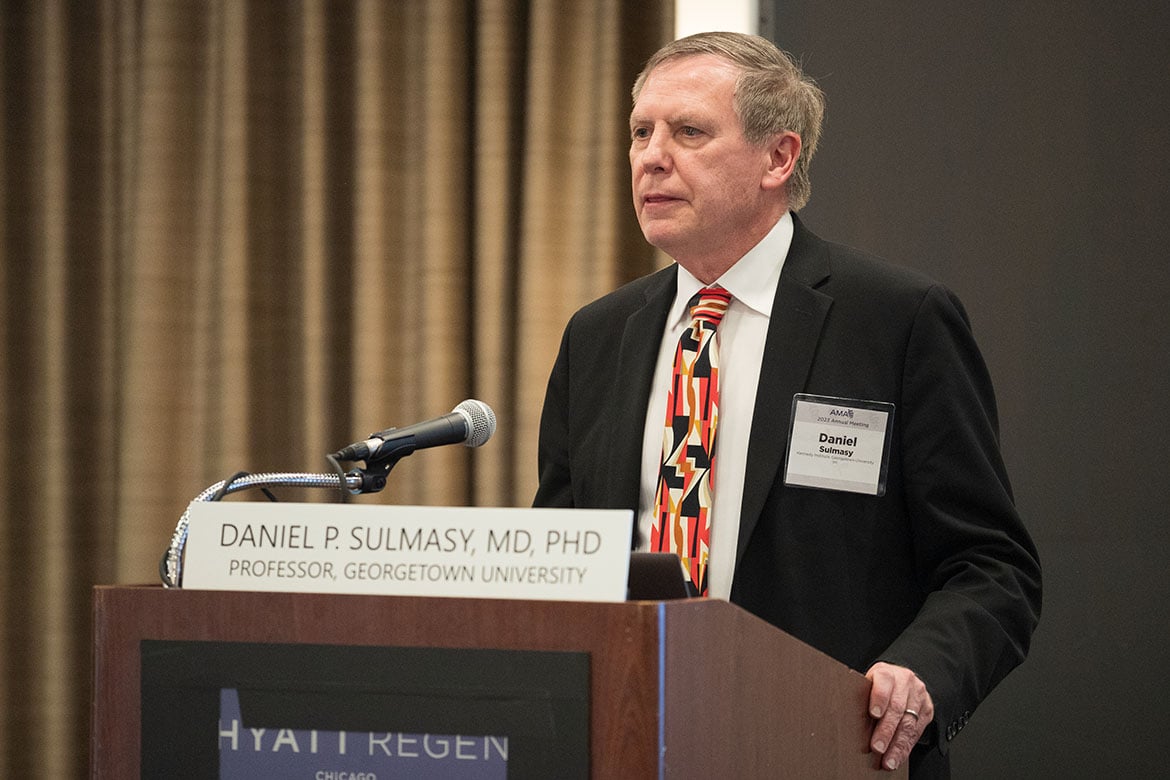Patient-centered care has become a cornerstone of medical ethics, and hospice and palliative care professionals have played a leading role in this process by focusing on the dignity of dying patients. But dignity has had many definitions over time, and even today it carries numerous meanings, each of which is relevant in its own way to the ethics of end-of-life care.
During a recent AMA Senior Physicians Section education session, “Dignity, Death and Patient Care” (login required), a physician bioethicist explored the various meanings of dignity and their implications for the treatment of advanced illness among older adults.
Layers of meaning
“The word dignity at its root means worth or value,” said Daniel P. Sulmasy, MD, PhD, professor of biomedical ethics in the Department of Medicine and Philosophy and director of the Kennedy Institute of Ethics at Georgetown University.
“But when we talk about it with respect to human beings, there are three different senses of dignity that are often confused,” Dr. Sulmasy said during the session, held as part of the 2023 AMA Annual Meeting in Chicago. “And sometimes when we're talking about care at the end of life, people are using the word in different means and therefore talking past each other.”
For that reason, it is essential for physicians to know the definitions of each, as detailed below.
Intrinsic dignity
“This is the value that each of us and each of our patients has by virtue of being the kind of thing that you and I and all of our patients are, which is human beings,” Dr. Sulmasy said.
“When we talk about human dignity in a political sphere or even in the bioethical sphere, we're talking about this intrinsic sense—the value that each of us has simply because we're human. It is in many ways the foundation of all of our talk about human rights.”
Attributed dignity
“We use this when we talk about how somebody values us or how we value other people, or even how we might come to value ourselves,” Dr. Sulmasy said. “It's a value that we confer on somebody else. When somebody says, ‘This work is beneath my dignity,’ they're using it not in the sense of being human, as being the source of value, but in the sense of what's attributed to them or how they view themselves.”
Inflorescent dignity
“It really means the value that we see in somebody who is a paragon of virtue, who is really showing what it means to flourish as a human being, often under conditions of great adversity,” he said. “So when we say, for instance, ‘She bore herself with great dignity,’ we're using it in this sense—not in a purely conventional sense, but in the sense of: This is a great example of a human being.”
The CME module “Dignity, Death and Patient Care” is enduring material and designated by the AMA for a maximum of 1 AMA PRA Category 1 Credit™. The session also included insights on day-to-day practice implementation from AMA governing council members Matthew D. Gold, MD, Narayana Murali, MD, and Mark C. Meyer, MD.
The module is part of the AMA Ed Hub™️, an online learning platform that brings together high-quality CME, maintenance of certification, and educational content from trusted sources, all in one place—with activities relevant to you, automated credit tracking, and reporting for some states and specialty boards.
Learn more about AMA CME accreditation.
How to approach them all
Such a complex notion can present troubling consequences for dying persons.
“There is no doubt that serious illness attacks their attributed dignities,” Dr. Sulmasy noted. “They appear different. They become dependent upon others. They are isolated. They are thought by some to have no value or less value because they're not productive members of society if they're bedbound and unable to participate. But the commitment is for us that they still have—always, indelibly—this intrinsic dignity.”
Likewise, accounting for every type of dignity may seem daunting for physicians providing end-of-life care, but Dr. Sulmasy outlined a framework for doing so.
“By respect for their intrinsic dignity, by care for their attributed dignity, by accompaniment [of their inflorescent dignity]—building up and fostering, to the extent we can, the conditions that will allow them to flourish even as they are dying,” he said, “committed to the idea that everybody, including someone who is dying, is a somebody.”
Dr. Sulmasy also discussed the importance of palliative sedation in dying, the arguments for and against assisted suicide and euthanasia, and the role of double effect in life-sustaining treatments.
Learn more with AMA Code of Medical Ethics’ Chapter 5, “Caring for Patients at the End of Life.”




